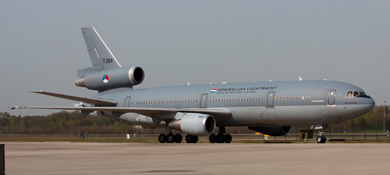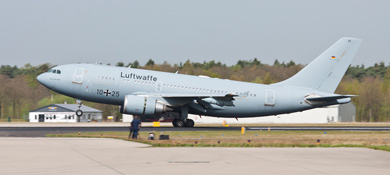From 31 March to 11 April, the first edition of the European Air Refueling Training (EART) was held at Eindhoven AB. Dutch, German and Italian tanker aircraft and their crews participated. This exercise was organized by the European Defence Agency in collaboration with the European Air Transport Command (EATC), concurrently with the exercise Frisian Flag at Leeuwarden AB. The purpose of the EART is to train crews in the refueling fighter aircraft, but also to certify their crews for refueling for as many type of aircraft as possible, to increase the employability of the European tankers.
Aerial refueling gap
The reason for organizing the EART was two-fold. Major Fred Frohlich, pilot of a KDC-10 of the Royal Netherlands Air Force and EART-project: "During Operation Unified Protector in 2011, NATO maintained a no-fly zone over Libya. This operation was fulfilled to stop the attacks by Libyan armed forces on its citizens. Additionally, the arms embargo applied to Libya, based on the Resolution 1973 of the UN, was maintained. The missions were executed by fighter aircraft of several participating NATO partners and required to be refueled in the air (Air-to-Air Refueling, AAR). Often several times per mission. Six of the NATO partners in Europe have tanker aircraft in service. Beside the fact that these aircraft are different types, they are also equipped with different tank systems (eg. probe or drogue-hose) and their corresponding procedures. Also not every tanker and their crew is certified for refueling aircraft of other European countries. Therefore, the missions during Unified Protector were largely dependent on tankers of the US Air Force. It showed that it is necessary to increase the efficiency and employability of the current European tanker fleet."
European Defence Agency (EDA)
In 2004, the European Union (EU) established the EDA. The EDA has among its task to improve the capabilities of the European defence in the field of crisis management and to offer support to the development of the future European defence. Following the lessons learned from Operation Unified Protector, the European Council of the EU has given the EDA the task to examine how they can improve the employability and efficiency of the tanker aircraft in Europe.
Lieutenant Colonel Metodi Metodiev of the Bulgarian Air Force, employed by the EDA as project AAR, explains about his task: "We have both actions for the short term and the longer term appointed, divided into four pillars. For a short-term solution at first we tried to hire commercial companies who can meet the need for AAR. The proposals submitted so far yielded no interest in the European member states. In addition, the availability of the current fleet needs to be optimized, including through mutual knowledge and increasing the number of certifications ." Metodiev continues:" Thirdly, we plan to make the A400M suitable for AAR. This is possible by placing so called AAR-kits inside its cargo bay, which is originally a transport aircraft. At last, for the long term we will increase the strategic tanker capability. The goal is to have an European tanker and strategic transport unit operational by 2020, which then operates with new tanker aircraft. The organizational structure and procedures of the unit will be similar to the Heavy Airlift Wing which operates three C-17A aircraft out of Pápa AB in Hungary. The choice of a particular tanker aircraft is currently being investigated." Possible candidates, at the moment, are the Boeing KC-46 (new tanker version of a Boeing 767) and the Airbus A330 MRTT (Multi Role Tanker Transport).
EART and Frisian Flag
Frisian Flag is an international exercise which aims to increase the cooperation between the participating countries and the different types of aircraft they are flying with. The pilots train among others in air defence and supplying air support to ground troops. Traditionally, aircraft of different types from various European countries participate in the Frisian Flag exercise. This edition there were about 50 aircraft. Because several complex and lengthy missions were planned, AAR was a necessary asset for the exercise. Therefore, the first edition of the EART was combined with this exercise at Leeuwarden Air Base. This gave participating crews of the EART the opportunity to train in aerial refueling in a realistic setting, with a large amount of receivers. The goals of the EART are, among others, to train the different rendez vous procedures and achieve further certification of the Italian tanker aircraft.
The participating tanker aircraft, a KDC-10 of the Royal Netherlands Air Force, an Airbus A310MRTT of the German Air Force and Italian KC-767 (only during the second week) have trained in refueling Dutch, Belgian and Portuguese F-16s. Germany and Spain participated with Eurofighters and Finland sent some F-18's. The practice area for AAR was located over the North Sea between the Netherlands and the western part of Denmark and consisted in an area of about 74,000 km2. The tankers were stationed at Eindhoven Air Base. The decision to operate out of Eindhoven AB was made because it's located relatively close to the target area and an additional objective of the EART is to implement Eindhoven Air Base as Forward Operation Base (FOB) and build up an AAR cell.
Metodiev: "After the EART, we will evaluate the progress of the exercise. Based on that information we determine whether we organize the EART again next year in this format or another, and whether there is sufficient cause to organize the exercise on a reoccurring base."
Global Air Power Media would like to thank Major Karen Keissen and Lieutenant Dick Hoeflaken and all involved in this exercise for their hospitality.






